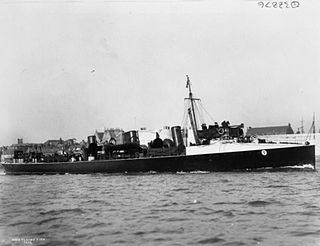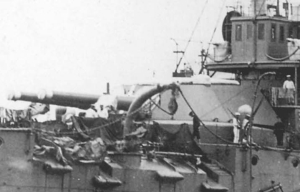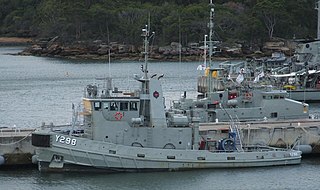
The M29 class comprised five monitors of the Royal Navy, all built and launched during 1915.

John Fredrick Thomas Jane was the founding editor of reference books on warships and aircraft and the namesake of what would become Jane's Information Group and many of its publications.
Janes is a global open-source intelligence company specialising in military, national security, aerospace and transport topics, whose name derives from British author Fred T. Jane.

The Erebus class of warships was a class of 20th century Royal Navy monitors armed with a main battery of two 15-inch /42 Mk 1 guns in a single turret. It consisted of two vessels, Erebus and Terror, named after the two ships lost in the Franklin Expedition. Both were launched in 1916 and saw active service in World War I off the Belgian coast. After being placed in reserve between the wars, they served in World War II, with Terror being lost in 1941 and Erebus surviving to be scrapped in 1946.
Antony Martin Douglas Leslie William Calhoun Preston was an English naval historian and editor, specialising in the area of 19th and 20th-century naval history and warship design.
The World Ship Society (WSS) is an international society devoted to maritime and naval history. Founded in 1946 as Ship News Club in order to distribute shipping information to correspondents, the society now has thousands of members in dozens of branches across the world. It publishes the monthly magazine Marine News and the quarterly magazine Warships for its membership.

Naval wargaming is a branch of the wider hobby of miniature wargaming. Generally less popular than wargames set on land, naval wargaming nevertheless enjoys a degree of support around the world. Both historical and fantasy rulesets are available.

HMS Whiting was a Palmer three funnel, 30 knot destroyer ordered by the Royal Navy under the 1896 – 1897 Naval Estimates. She was the fifth ship to carry this name.

HMS Crane was a Palmer three-funnel, 30-knot destroyer ordered by the Royal Navy under the 1895–1896 Naval Estimates. She was the sixth ship to carry this name since it was introduced in 1590 for a 24-gun schooner in service until 1629.

HMS Flying Fish was a Palmer three funnel, 30 knot destroyer ordered by the Royal Navy under the 1896 – 1897 Naval Estimates. She was the tenth ship to carry this name.
HMS Sylvia was a Doxford three funnel - 30 knot destroyer ordered by the Royal Navy under the 1896 – 1897 Naval Estimates. She was the sixth ship to carry this name since it was introduced in 1806 for a cutter sold in 1816.

The Armstrong Whitworth 12-inch naval gun of 40 calibres length was designed by and manufactured mainly by Armstrong's ordnance branch, Elswick Ordnance Company. It was intended for the Royal Navy's Royal Sovereign-class battleships, but budgetary constraints delayed their introduction. The first units were instead supplied to Japan. As the Type 41 12-inch (305 mm) 40-calibre naval gun it was the standard main battery on several early United Kingdom-built pre-dreadnought battleships of the Imperial Japanese Navy.

The Bandicoot class was a ship class of two minesweeper tugboats operated by the Royal Australian Navy (RAN). MSA Bandicoot and MSA Wallaroo were built in 1982 for Maritime (PTE) Ltd. as the tugboats Grenville VII and Grenville V. In 1990, the RAN purchased the vessels for conversion into auxiliary minesweepers under the Craft of Opportunity Program (COOP). The vessels could be equipped with a sidescan sonar and various towed minesweeping arrays, and also functioned as berthing tugs. Both vessels were placed in reserve in 2010, but were deployed on several occasions since to provide berthing support to nuclear-powered warships. They were removed from naval service in 2014.

Flottes de combat, translated as Combat Fleets of the World, is an almanac and a reference book of information of the world's warships arranged by nation, including information on ships' names, dimensions, armaments, silhouettes, photographs, etc. It is published in French and English. Its editions cover the warships used by national naval and paramilitary forces, and provide data on their characteristics.

HMS Fawn was a Palmer three funnel, 30 knot destroyer ordered by the Royal Navy under the 1896 – 1897 Naval Estimates. She was the fourth ship to carry this name.
HMS Lee was a Doxford three funnel - 30 knot destroyer ordered by the Royal Navy under the 1898 – 1899 Naval Estimates. She was the sixth ship to carry this name since its introduction in 1776 for a 6-gun sloop for service on the Great Lakes.
HMS Vixen was a Vickers three funnel - 30 knot destroyer ordered by the Royal Navy under the 1895 – 1896 Naval Estimates. She was the fourth ship to carry this name since it was introduced in 1801 for an 18-gun brig sold 1815.

Oscar Parkes was a Royal Navy surgeon, naval historian, marine artist, and editor of Jane's Fighting Ships from 1918 to 1935. He was an associate of the Royal Institution of Naval Architects. The Imperial War Museum and the National Maritime Museum have permanent collections of his artwork. His book British Battleships: "Warrior", 1860 to "Vanguard", 1950. A History of Design, Construction and Armament is regarded as a definitive source.

IRIS Neyzeh is a Kaman-class fast attack craft in the Southern Fleet of the Islamic Republic of Iran Navy.
Christopher Frank Foss is a British military author. Since 1970, he has worked for the military publisher Jane's Information Group. He is editor of Janes Armour and Artillery and co-editor of other Jane's editions.
Brooks, Richard. Fred T. Jane: An Eccentric Visionary. Coulsdon, Surrey: Jane's Information Group, 1997.













